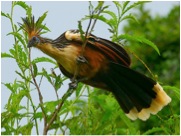Permafrost metagenome study on VOA Special English report
The researchers say one gram of the soil could contain thousands of different kinds of microbes and billions of cells. They say these organisms had never before been cultured in a laboratory. JANET JANSSON: “So more than ninety percent of those bacteria and other microorganisms in permafrost, we had no idea what they were.” Read… [Read More]
